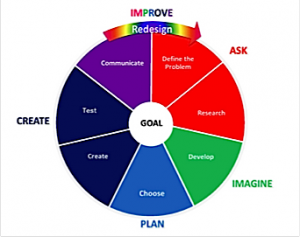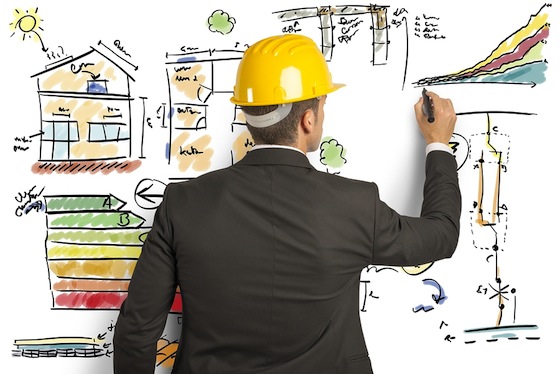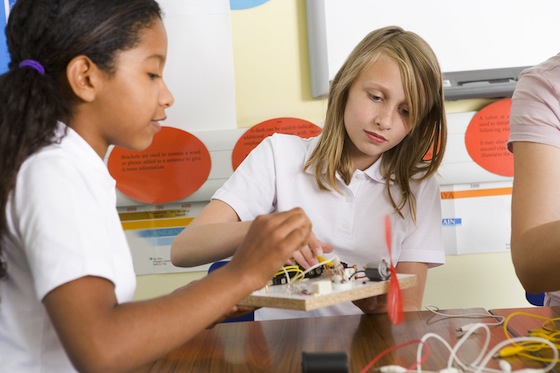What Makes Something STEM?
A MiddleWeb Blog
 STEM is a growing young initiative in the K-12 learning arena. Many people are still trying to wrap their heads around it. Teachers are still wondering, “I teach science (or I teach technology, or I teach math), so am I teaching STEM?”
STEM is a growing young initiative in the K-12 learning arena. Many people are still trying to wrap their heads around it. Teachers are still wondering, “I teach science (or I teach technology, or I teach math), so am I teaching STEM?”
I recently finished co-teaching a STEM/STEAM eCourse with colleague Nancy Flanagan and guest Dr. Susan Pruet. We found that many people are wrestling with questions about what STEM is, how it’s different from traditional math and science classes, and how engineering fits in.
Before figuring out what makes something STEM, educators need to understand what STEM is supposed to accomplish. STEM is a way to achieve specific workforce-related goals, although it also focuses on life skills that all students need. I generally start a STEM class for educators by reminding folks exactly why STEM became such a hot topic.
Why the urgency around STEM?
► Our workforce has a growing need for workers with 21st century skills. The current demand for STEM-capable workers is greater than the supply of applicants who are prepared for STEM careers. So, what 21st Century skills do our kids need to be successful in the workforce and in life in the high-tech, post-digital age? The ultimate goal of STEM is to address that question and prepare students with these skills.
► Currently our biggest demand is for workers who understand math and science and can apply what they know. According to The Atlantic, more and more U.S.-based jobs require workers who possess practical expertise in science, technology, engineering and mathematics. Our students need to understand and be able to apply concepts from algebra, geometry, trigonometry, biology, chemistry, physics and other important disciplines. Currently, American kids are falling short.
STEM intentionally gives students experience in integrating and applying rigorous math and science to solve problems. Since STEM can’t focus on every science and math objective, a good rule of thumb is to focus on the most important learning goals in each discipline.
In addition to rigorous science and math, I often discuss some other 21st century skills students need to master. This list will likely look familiar.
• Collaboration and teamwork
• Critical thinking and problem solving
• Communication on multiple levels
• Entrepreneurship, resourcefulness, and resilience
• Creativity and innovation
• A sense of civic responsibility
So, in addition to applying science and math, STEM should build specific kinds of life skills and personal qualities. Civil responsibility, for example, is a personal quality that often develops through identifying and solving real-world problems.
Why include engineering?
Another biggie for STEM is the use of a design process for helping kids think through and solve problems that I usually refer to as “engineering challenges” or “STEM challenges.”
Why would students need to use an engineering design process? This is considered a non-negotiable in most STEM projects, since this is the type of thinking that engineers and related professionals go through when they create innovative solutions for real world problems. Our students need to graduate with specific thinking skills that can help them approach diverse challenges.

There are several versions of this engineering design process. (Go to Google image search and type in Engineering Design Process). All contain the same basic steps. The higher the grade level, the more steps are typically included.
Once the educators in my class have looked at the impetus behind STEM and what skills workers need in 21st century jobs, they can understand the need to develop students who are ready for STEM careers. That informs our understanding of what makes something STEM.
So what’s the acid test for a STEM project?
At this point, I invite my adult learners to brainstorm some ideas. When it comes to student STEM projects, what are some defining characteristics? Here are several we have come up with:
- Features integrated and applied math and science
- Revolves around an Engineering Design Process
- Engages kids in creating, testing, and evaluating prototypes
- Builds a mindset of continual improvement and redesign
- Involves an inquiry-based teaching approach and hands-on investigation
- Involves students in working and solving problems in teams
- Provides students with a risk-free atmosphere in which to make mistakes and try again
Those are some significant things that make something STEM.
Try my “Is It STEM?” checklist
One way to examine our programs to see if they meet the STEM test is to make a rubric or checklist incorporating characteristics like those we brainstormed. What follows might be a starter set of questions to examine proposed or existing STEM projects. This is not comprehensive, but the answers to the following queries can generally reveal whether a program is STEM.
STEM Content:
- How was math integrated and applied?
- How was science integrated and applied?
- How was technology integrated (or created)?
- How was the Engineering Design Process used?
Students:
- How successfully were students able to engage in team problem-solving?
- Were they comfortable viewing failure as okay, and as a next step in a search for an answer?
- To what extent did students consider multiple right ways to approach and solve the problem?
- Did student teams develop and test a prototype for solving the problem?
Teachers:
- Do teachers have deep content knowledge in their field?
- Do teachers have the pedagogical skill to make that content accessible to students?
- Are the teachers skilled at guiding and facilitating learning?
- Do teachers have the resources and training they need in STEM?
What makes something STEM?
Classrooms with students engaged and interested in being scientists, mathematicians, and engineers and having the habits of mind and the skill sets to do that. Our programs need to include real and rigorous STEM work. For the sake of our 21st century students, our communities and our national infrastructure, we need to get this right.































